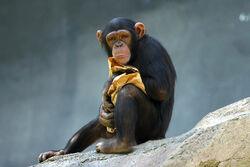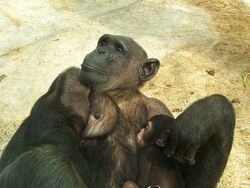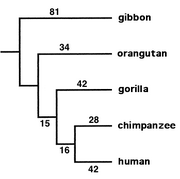Assessment |
Biopsychology |
Comparative |
Cognitive |
Developmental |
Language |
Individual differences |
Personality |
Philosophy |
Social |
Methods |
Statistics |
Clinical |
Educational |
Industrial |
Professional items |
World psychology |
Animals · Animal ethology · Comparative psychology · Animal models · Outline · Index
| ?Common Chimpanzee[1] Conservation status: Endangered[2] | ||||||||||||||
|---|---|---|---|---|---|---|---|---|---|---|---|---|---|---|
 | ||||||||||||||
| Scientific classification | ||||||||||||||
| ||||||||||||||
| Pan troglodytes (Blumenbach, 1775) | ||||||||||||||
| distribution of Common Chimpanzee. 1. Pan troglodytes verus. 2. P. t. vellerosus. 3. P. t. troglodytes. 4. P. t. schweinfurthii. distribution of Common Chimpanzee. 1. Pan troglodytes verus. 2. P. t. vellerosus. 3. P. t. troglodytes. 4. P. t. schweinfurthii.
|
The Common Chimpanzee (Pan troglodytes), also known as the Robust Chimpanzee, is a great ape. The name troglodytes, Greek for 'cave-dweller', was coined by Johann Friedrich Blumenbach in his Handbuch der Naturgeschichte (Handbook of Natural History) published in 1779. Colloquially, it is often called the chimpanzee (or simply 'chimp'), though technically this term refers to both species in the genus Pan: the Common Chimpanzee and the closely-related bonobo, or Pygmy Chimpanzee.
Several subspecies of the Common Chimpanzee have been recognized:
- Central Chimpanzee, Pan troglodytes troglodytes, in Cameroon, the Central African Republic, Equatorial Guinea, Gabon, the Republic of the Congo, and the Democratic Republic of the Congo;
- West African Chimpanzee, Pan troglodytes verus, in Guinea, Mali, Sierra Leone, Liberia, Côte d'Ivoire, Ghana, and Nigeria;
- West Nigeria/East Cameroon or simply Nigerian Chimpanzee, Pan troglodytes vellerosus, in Nigeria and Cameroon;
- Eastern Chimpanzee, Pan troglodytes schweinfurthii, in the Central African Republic, the Sudan, the Democratic Republic of the Congo, Uganda, Rwanda, Burundi, Tanzania, and Zambia.
Basic facts[]
Common Chimpanzees are found in the tropical forests and wet savannas of Western and Central Africa. They once inhabited most of this region, but their habitat has been dramatically reduced in recent years.
Adults in the wild weigh between 40 and 65 kg (88 and 143 lb); males can measure up to 160 cm (63 inches) and females to 130 cm (51 inches), and although lighter than humans they have a pull five to six times stronger[1] This is because the muscles of chimpanzees and other primates are far more effective than those of humans.[2] Their bodies are covered by a coarse dark brown hair, except for the face, fingers, toes, palms of the hands and soles of the feet. Both their thumbs and their big toes are opposable, allowing a precision grip. Their gestation period is eight months. Infants are weaned when they are about three years old, but usually maintain a close relationship with their mother for several more years; they reach puberty at the age of eight to ten, and their lifespan in captivity is about fifty years.
Although omnivores, their diet is mainly vegetarian, consisting of fruits, leaves, nuts, seeds, tubers, and miscellaneous plantlife, supplemented by insects and small prey. There are also instances of organized hunting; in some cases, such as the killing of leopard cubs, this primarily seems to be a protective effort. However, Common Chimpanzees sometimes band together and hunt Western Red Colobus monkeys (Piliocolobus badius) for their meat. Isolated cases of cannibalism have been documented. Chimpanzees have also been known on rare occasions to attack and eat human infants.[3]
Behavior[]

Common Chimpanzee and his mother.
Common Chimpanzees live in communities that typically range from twenty to more than 150 members, but spend most of their time traveling in small parties of just a few individuals. They are both arboreal and terrestrial, spending equal time in the trees and on the ground. Their habitual gait is quadrupedal, using the soles of their feet and resting on their knuckles, but they can walk upright for short distances. Common Chimpanzees are 'knuckle walkers', like gorillas, in contrast to the quadrupedal locomotion of orangutans and bonobos, 'palm walkers' who use the outside edge of their palms.
The Common Chimpanzee lives in a fission-fusion society, where mating is promiscuous, and may be found in groups of the following types: all-male, adult females and offspring, consisting of both sexes, one female and her offspring, or a single individual. At the core of social structures are males, who roam around, protect group members, and search for food. Among males, there is generally a dominance hierarchy. However, this unusual fission-fusion social structure, "in which portions of the parent group may on a regular basis separate from and then rejoin the rest",[4] is highly variable in terms of which particular individual chimpanzees congregate at a given time. This is mainly due to chimpanzees having a high level of individual autonomy within their fission-fusion social groups. Also, communities have large ranges that overlap with those of other groups.
As a result, individual chimpanzees often forage for food alone, or in smaller groups (as opposed to the much larger parent group, which encompasses all the chimpanzees who regularly come into contact and congregate into parties in a particular area). As stated, these smaller groups also emerge in a variety of types, for a variety of purposes. For example, an all-male troop may be organized in order to hunt for meat, while a group consisting of one mature male and one mature female may occur for the purposes of copulation. An individual may encounter certain individuals quite frequently, but have run-ins with others almost never or only in large-scale gatherings. D ue to the varying frequency at which chimpanzees associate, the structure of their societies is highly complicated.
Chimpanzee Genome Project[]
- Main article: Chimpanzee Genome Project

The ape clade. Chimpanzees are the closest living relatives to humans. The numbers in this diagram provide an estimate of relatedness based on similarities in proteins between the various apes.
Human and Common Chimpanzee DNA is very similar. After the completion of the Human genome project, a Common Chimpanzee Genome Project was initiated. In December of 2003, a preliminary analysis of 7600 genes shared between the two genomes confirmed that certain genes, such as the forkhead-box P2 transcription factor which is involved in speech development, have undergone rapid evolution in the human lineage. A draft version of the chimpanzee genome was published on September 1, 2005, in an article produced by the Chimpanzee Sequencing and Analysis Consortium[5]. The DNA sequence differences between humans and chimpanzees is about thirty-five million single-nucleotide changes, five million insertion/deletion events, and various chromosomal rearrangements. Typical human and chimp protein homologs differ in only an average of two amino acids. About 30% of all human proteins are identical in sequence to the corresponding chimp protein. Duplications of small parts of chromosomes have been the major source of differences between human and chimp genetic material; about 2.7% of the corresponding modern genomes represent differences, produced by gene duplications or deletions, during the approximately four to six million years since humans and chimps diverged from their common evolutionary ancestor. Results from human and chimp genome analyses, currently being conducted by geneticists including David Reich, should help in understanding the genetic basis of some human diseases.
Link with Human Immunodeficiency Virus type 1[]
Two species of Human Immunodeficiency Virus (HIV) infect humans: HIV-1 and HIV-2. HIV-1 is the more virulent and easily transmitted, and is the source of the majority of HIV infections throughout the world; HIV-2 is largely confined to west Africa.[6] Both species originated in west and central Africa, jumping from primates to humans. HIV-1 has evolved from a Simian Immunodeficiency Virus (SIVcpz) found in the Common Chimpanzee subspecies, Pan troglodytes troglodytes, native to southern Cameroon.[7][8] Kinshasa, in the Democratic Republic of Congo, has the greatest genetic diversity of HIV-1 so far discovered, suggesting that the virus has been there longer than anywhere else. HIV-2 crossed species from a different strain of SIV, found in the Sooty Mangabey, monkeys in Guinea-Bissau.[6]
Divergence from the Bonobo[]
Recent DNA evidence suggests the Bonobo and Common Chimpanzee species separated from each other less than one million years ago.[9][10] The chimpanzee line split from the last common ancestor of the human line approximately six million years ago. Because no species other than Homo sapiens has survived from the human line of that branching, both chimpanzee species are the closest living relatives of humans.
See also[]
- Jane Goodall
- Great Ape personhood
- List of apes - notable individual apes
- Washoe, Nim Chimpsky
References[]
- ↑ Groves, Colin (16 November 2005). Wilson, D. E., and Reeder, D. M. (eds) Mammal Species of the World, 3rd edition, 183, Johns Hopkins University Press. ISBN 0-801-88221-4.
- ↑ Butynski et al (2000). Pan troglodytes. 2006 IUCN Red List of Threatened Species. IUCN 2006. Retrieved on 10 May 2006. Database entry includes justification for why this species is endangered
- ↑ (2003). Frodo: The Alpha Male. URL accessed on 2006-12-06.
- ↑ Goodall, Jane (1986). The Chimpanzees of Gombe: Patterns of Behavior.
- ↑ Chimpanzee Sequencing and Analysis Consortium (2005). Initial sequence of the chimpanzee genome and comparison with the human genome. Nature 437: 69-87. (September 1) Entrez PubMed 16136131; Cheng Z, Ventura M et al. (2005). A genome-wide comparison of recent chimpanzee and human segmental duplications. Nature 437: 88-93. (September 1) Entrez PubMed 16136132
- ↑ 6.0 6.1 Reeves, J. D. and Doms, R. W (2002). Human Immunodeficiency Virus Type 2. J. Gen. Virol. 83 (Pt 6): 1253-1265. PMID 12029140.
- ↑ Keele, B. F., van Heuverswyn, F., Li, Y. Y., Bailes, E., Takehisa, J., Santiago, M. L., Bibollet-Ruche, F., Chen, Y., Wain, L. V., Liegois, F., Loul, S., Mpoudi Ngole, E., Bienvenue, Y., Delaporte, E., Brookfield, J. F. Y., Sharp, P. M., Shaw, G. M., Peeters, M., Hahn, B. H. (2006). Chimpanzee Reservoirs of Pandemic and Nonpandemic HIV-1. Science. #REDIRECT Template:Doi.
- ↑ Gao, F., Bailes, E., Robertson, D. L., Chen, Y., Rodenburg, C. M., Michael, S. F., Cummins, L. B., Arthur, L. O., Peeters, M., Shaw, G. M., Sharp, P. M. and Hahn, B. H. (1999). Origin of HIV-1 in the Chimpanzee Pan troglodytes troglodytes. Nature 397 (6718): 436-441. PMID 9989410.
- ↑ Won, Yong-Jin, Hey, Jody (2005). Divergence Population Genetics of Chimpanzees. Molecular Biology & Evolution 22 (2): 297-307. DOI:10.1093/molbev/msi017.
- ↑ Fischer, Anne et al. (2004). Evidence for a Complex Demographic History of Chimpanzees. Molecular Biology & Evolution 21 (5): 799-808. DOI:10.1093/molbev/msh083.
External links[]
.
- Jane Goodall web site
- DiscoverChimpanzees.org
- Chimp Haven, The National Chimpanzee Sanctuary (ChimpHaven.org)
- Chimpanzee Genome resources
- Primate Info Net Pan troglodytes Factsheets
- U.S. Fish & Wildlife Service Species Profile
- New Scientist 19 May 2003 - Chimps are human, gene study implies
- The common chimpanzee
| This page uses Creative Commons Licensed content from Wikipedia (view authors). |